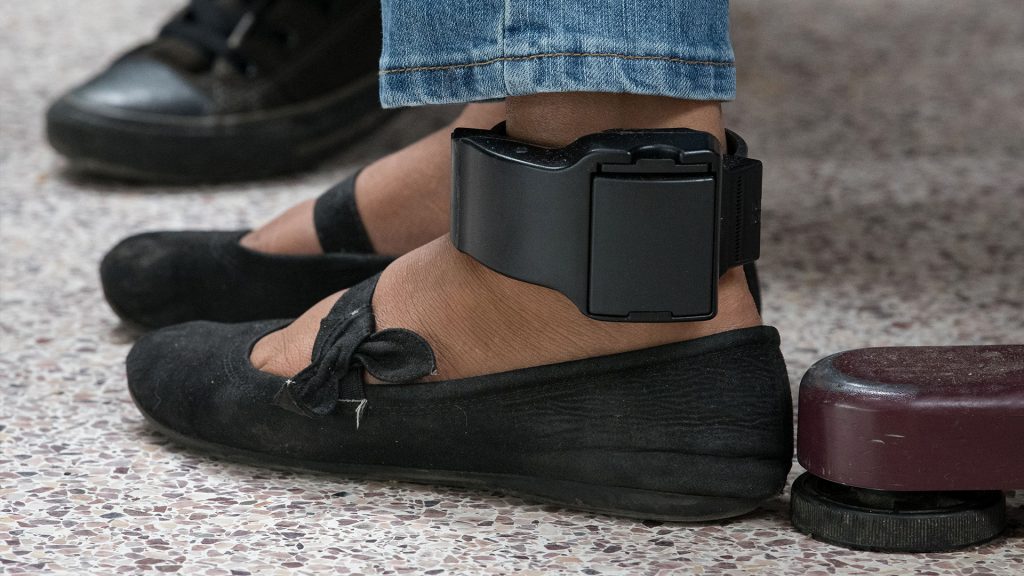ICE aims to expand number of migrants tracked with ankle monitors: Report

U.S. Immigration and Customs Enforcement is moving to dramatically increase the number of immigrants fitted with GPS-equipped ankle monitors. The directive, first reported by The Washington Post, comes as the Trump administration ramps up surveillance of migrants it aims to deport.
Current number of ATD enrollees
In a June 9 memo, ICE directed staff to fit people in the agency’s Alternatives to Detention (ATD) program with ankle monitors “whenever possible.” Around 183,000 adult immigrants are enrolled in ATD and have previously consented to some form of tracking or required check-ins while their cases are pending. But currently, only 24,000 of them wear ankle monitors, according to the Post.
Some exceptions granted
The Post reports that exceptions to the ankle monitors are granted for individuals such as pregnant women, who are mandated to wear wrist monitors.
Enforcement and Removal Operations Non-Detained Management Division’s Acting Assistant Director Dawnisha M. Helland, who oversees the management of non-detained migrants, stated in the letter, “If the alien is not being arrested at the time of reporting, escalate their supervision level to GPS ankle monitors whenever possible and increase reporting requirements.”
Critics argue the ankle monitors are inhumane and unfair
The new directive marks a significant expansion of the two-decade-old surveillance program. While some critics acknowledge that the devices are more humane than detention centers, they argue the six-ounce monitors are uncomfortable, stigmatizing and invasive.
“This will be a tool used to extend the reach of the government from just the folks it can manage to put in physical detention, to an additional hundreds of thousands more that it can surveil,” Laura Rivera, a senior staff attorney at Just Future, a nonprofit organization that has performed studies on ICE tracking technologies, told the Post. “It’s designed to turn their own communities and homes into digital cages.”
ICE’s response
ICE spokesperson Emily Covington declined to comment on the memo but acknowledged the agency is using ankle monitors as an “enforcement tool” to ensure compliance with federal law. She emphasized that “more accountability shouldn’t come as a surprise.” Covington added that ICE still makes determinations based on each individual case, and officials still maintain discretion to decide which immigrants are required to wear monitors.
ICE mandates that most unauthorized immigrants attend court hearings or check in from time to time at field offices while their cases are resolved. The frequency of check-ins is based on a variety of factors, including criminal history.
“Maybe they’ve taken these drastic steps because many people don’t show up to court or change addresses without reporting,” Paola, a mother of two who fled Honduras, told the Post. “But some of us do everything right and still get treated the same.”
Most undocumented immigrants are in compliance
Critics argue that the added surveillance is unnecessary. They point to an analysis of federal data by the American Immigration Council, an immigrant rights organization, which reports that 83% of non-detained migrants with resolved or pending deportation cases attended all of their court hearings from 2008 to 2018.
Geo Group’s role
The expected increase in the number of ankle monitors worn is reportedly expected to lead to more business for Geo Group, a Florida-based private prison corporation. In the past, the group has employed at least two of President Donald Trump’s top immigration officials and given more than $1.5 million to Trump’s 2024 campaign and inauguration fund. The surveillance program is run entirely by BI Inc., which is a subsidiary of Geo. Geo first began its business in the 1970s, selling monitoring devices to farmers to monitor livestock.
Geo Group is ICE’s largest contractor. It has already seen more business amid Trump’s enhanced deportation and immigration enforcement efforts. ICE has entered into contracts with Geo to reopen a number of Geo detention facilities and to finance deportation flights on Geo’s air carrier. Recently, the agency gave BI a one-year extension on its migrant-tracking contract, in the process, forgoing a competitive bidding procedure that would’ve opened the program to new companies.
Tom Homan’s prior role in Geo
Trump’s “border czar,” Tom Homan, has previously received consulting fees from the division of Geo that manages immigrant monitoring. A White House spokesperson emphasized that Homan recuses himself from all negotiations on government contracts.
Geo may not be able to meet ICE’s demands
Still, as ICE expands the program, sources tell the Post that the agency may be looking for additional companies because of concerns that Geo doesn’t have the infrastructure to support all of its technological demands.
Despite Geo’s willingness to expand its capacity, there are concerns that the company can no longer meet surging demand. BI has been plagued for years by problems with recycled old ankle bracelets that are shifted from one enrollee to the next, according to former workers, and the supply of its monitors is reportedly old and in poor condition. BI would also have to rapidly hire more case managers to ensure that each enrollee is fulfilling legal requirements, as case managers are already overburdened. An analysis by The Guardian in 2022 showed that each case manager was already managing up to 300 enrollees at once, stretching them thin and leaving limited time to prioritize individual needs.
ICE has reportedly requested that Geo employ more subcontractors to bulk up the tracking program. ATD may also expand to include other tracking devices and technology other than ankle bracelets, depending on the equipment ICE can buy in a short amount of time, according to sources familiar with the discussions who spoke with the Post.
ATD numbers down from a peak under Biden
Currently, only a fraction of immigrants with pending cases are enrolled in ATD in addition to meeting with case managers in their home or a BI office. Those enrolled in ATD reached their highest numbers at 378,000 under the Biden administration, as border crossings spiked, but numbers have since declined.
ICE says it considers multiple factors when deciding how to track each enrollee – including criminal history, past compliance, medical issues and caregiving responsibilities. Since ATD’s launch in 2004, some enrollees have reported cases of being unfairly surveilled despite following all the rules and presenting no danger to their communities.
“There were individuals that should not have been in the program and should have been released on their own recognizance,” said Hector Equihua, a former BI case manager.
The latest numbers
Of those currently in ADT, 84% are monitored via SmartLINK, a mobile app that uses facial recognition and GPS for check-ins. According to ICE data reviewed by the Post, as of July 12, only 13% wear ankle monitors – but that number has risen under the Trump administration, which has added 4,165 enrollees since January.





